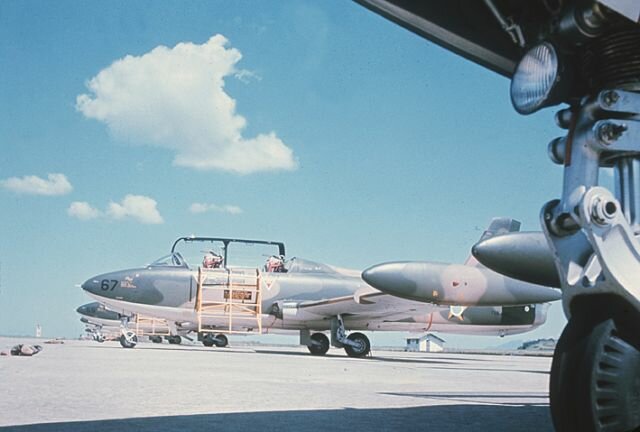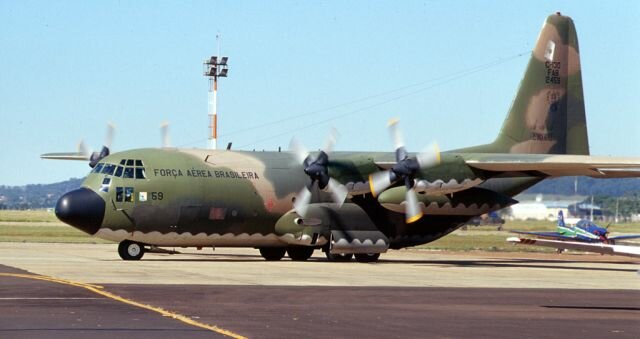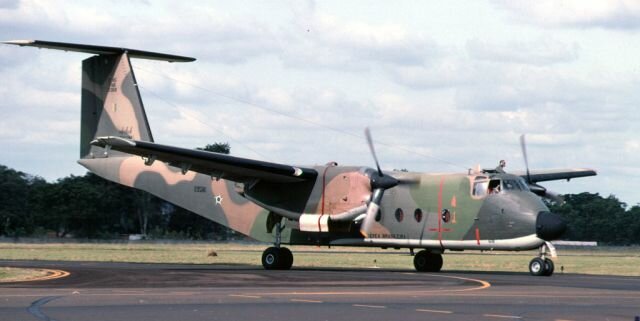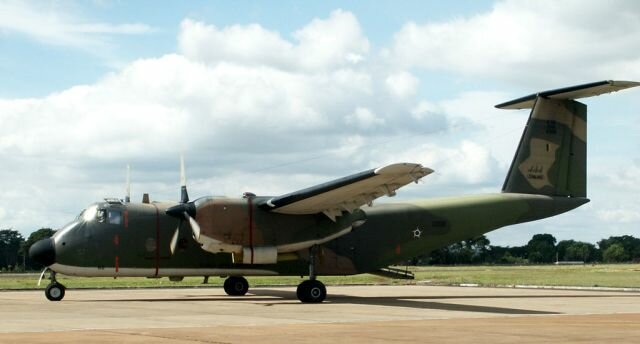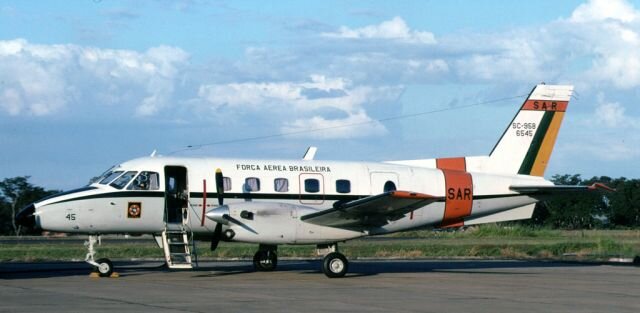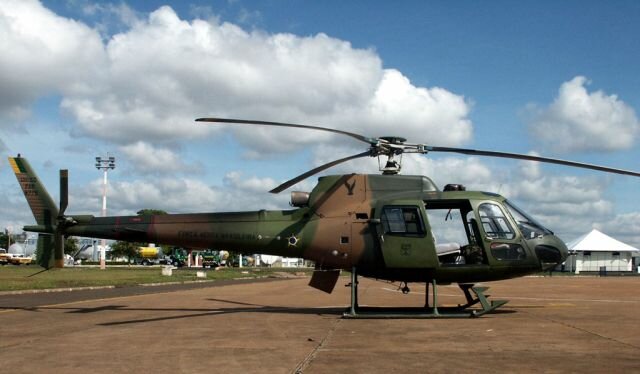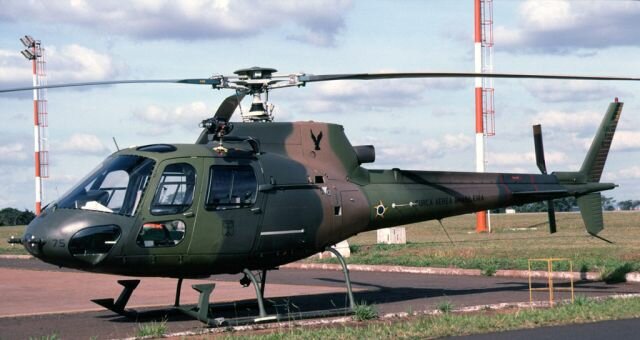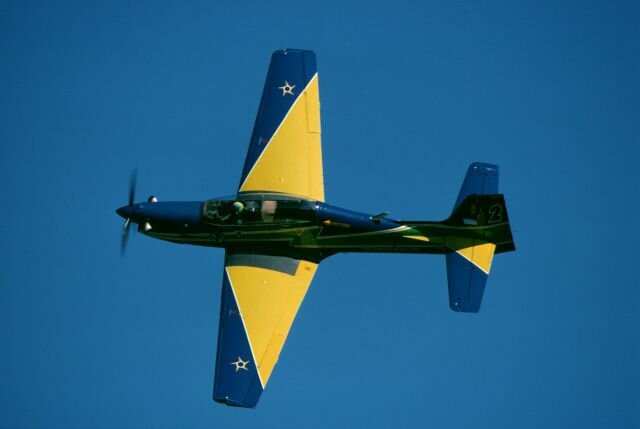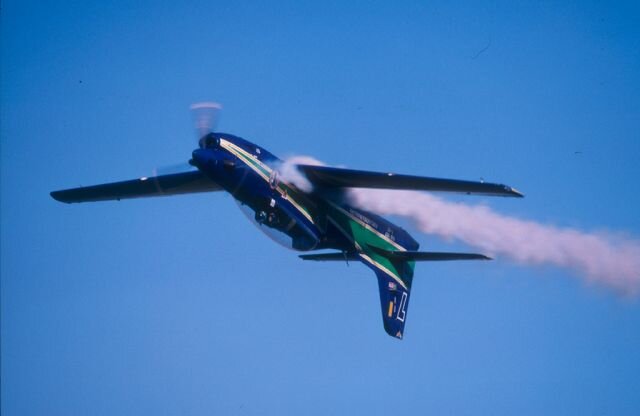|
From ACIG.org Central and Latin America Database
Brazil is going through a reform in the way that it defends its borders and projects its force. Brazilian President, Luis Ignacio Lula da Silva, has stated that he wishes to start a nuclear weapons program and that the conventional armed forces will be greatly enhanced. The Brazilian Air Force (FAB) has based its current modernization and expansion program on the SIVAM- Integrated Amazon Surveillance System. Over the past decade, SIVAM has been formed by several linked programs such as a new land based, Raytheon-designed 3-D radar network, an Airborne Early Warning (AEW) and a light fighter (ALX) program. The next generation of FAB programs are centered on replacing outdated technology. Such as the F-X (new multi-role fighter), P-X (new maritime patrol aircraft) and CL-X (new light transport aircraft). A novelty for the FAB will be the introduction of heavy-lift helicopters through CH-X project. The National Defense Council has already selected most of the preferred types, but the final decision will include economic and political considerations. Although announced, the final decision has been postponed several times. The FAB has been keen in keeping these programs alive, as it considers them vital for Brazil’s defense in the 21st Century.
The long-serving Ministry of Aeronautics, in charge of Brazilian Air Force and Civilian Aviation, became the Aeronautics Command (COMAER) in December 2000, becoming directly subordinate to the Ministry of Defense. COMAER is formed by three General Commands: The General Air Command (COMGAR), basically the FAB’s spine, has command over all air forces in the regional commands, General Support Command (COMGAP) is tasked with maintenance and logistics, while the General Personnel Commando is in charge of the 68,000 people that make up the FAB. There are three independent departments, directly subordinated to the COMAER. The Training Department (DEPENS), that operates the Air Force Academy (AFA) ; the Specialists School (EEAR) and the Air Cadet Prep School (EPCAR). The Civilian Aviation Department (DAC) is in charge of regulating civilian aviation and operate Infraero, a government company responsible for building airports and managing control of the national airspace. The Research and Development Department (DEPED) is made up of the Technical Aerospace Centre (CTA) and the Aeronautic Technology Institute (ITA). Brazilian air space is divided into 7 air regions, each of which houses a Regional HQ responsible of the designated air bases. 1° Comando Regional - Belém 2° Comando Regional - Recife 3° Comando Regional - Río de Janeiro 4° Comando Regional - Sao Paulo 5° Comando Regional - Porto Alegre 6° Comando Regional - Brasilia 7° Comando Regional - Manaus However, unit operations fall under the responsibility of each of the three designated air forces. There are different types of units, usually each unit operates a single aircraft model with a specific tasks. The standard general purpose unit is the Aviation Group (GAV), Fighter Air Group (GAVCA), Transport Group (GT), Troop Transport Group (GTT) and Air Defense Group (GDA). There are also smaller, usually independent units, known as Liaison and Observation Flights (ELO) or Air Training Flights (EIA). The 2nd Air Force has its HQ in Rio de Janeiro and has some 240 aircraft organized into four GAVs. The 7th GAV is in charge of Coastal Patrol, flying some 21 EMB-111 Banderhuilas (locally known as P-95) from four air bases. P-95’s are armed for anti-ship (ASV) and anti-submarine warfare (ASW). The 8th GAV is formed by five squadrons, comprising UH-1H transport, Super Puma assault and Esquilo scout helicopters plus a few Neiva Seneca and T-25 Universal light aircraft for FAC. The 2nd Air Force’s most important program is named P-X, designed to provide the FAB with two flights of ASW and Maritime Patrol aircraft and is worth some $330 million. These squadrons will patrol Brazilian territorial waters to the limit, bordering African waters. Up to six different companies provided proposals. The FAB selected the EADS-CASA proposal, which included refurbished and upgraded ex-US Navy P-3B Orions. Nine P-3B’s are to have the new EADS-CASA FITS system integrated in Spain while a further three examples have been delivered to EMBRAER, where they will be dismantled and stored as spares source. The upgraded P-3BR are to for up to two squadrons of MP/ASW aircraft from 2005. Total requirement may be up to 19 aircraft. However, this program has been shelved pending re-negotiation and a governmental decision of weather to go ahead with it or cancel it in favor of social reform programs. The next program on the 2nd Air Force’s agenda is designed to provide the FAB with heavy-lift helicopters. CH-X will provide four machines worth some $110 million to directly support the SIVAM program. Prospective candidates include the Mi-26 Halo, CH-47SD Chinook, Sikorsky S-92 and the NH-90. Mi-26 was the clear favorite by the FAB and negotiations started in October 2003 during a visit by Russia’s Defense Minister to Brazil. The FAB also showed interest in replacing its current fleet of Hueys with the Mi-171. However this has been discarded as the Brazilian government has contracted Bell Helicopters Textron to upgrade the current fleet with new engines, avionics and structure. The Hueys will be replace by new machines by 2010. Recently, the FAB has shown an increased interest in the South African CSH-2 Rooivalk combat support helicopter. The FAB requirement (AH-X?), as part of SIVAM, may be up to 24 Rooivalks to replace armed UH-1H’s in the armed recon/escort role. The III Air Force is responsible for the FAB jet fighter fleet, and has its HQ in Brasilia. It operates close to 300 aircraft organized into nine Aviation Groups and a single observation flight. The country’s first line of defense is the 1st Air Defence Group (GDA), armed with Mirage III interceptors. The Mirage was selected for FAB service in the late 1960s. The Aeronautics Ministry managed a program called CEPAI (Comissao de Estudos do Projeto da Aeronave da Interceptacao – Interceptor Aircraft Studies Project Commission), which designated the F-4E Phantom II as the preferred aircraft. However US policy prevented the Phantom from wearing Brazilian colors at the time and the French option was taken instead. The FAB signed a contract for 12 Mirage IIIE single and 4 Mirage IIIB two-seaters to arm the 1st Air Defense Wing in May 1970. Mirage deliveries where completed in October 1973 to a new fighter base, Anapolis, located some 90 miles from Brasilia. An attrition replacement was bought in 1977 and a further 6 ex-Armée de l’ Air Mirage III’s where obtained in the mid 1980s. A French offer for up to 20 additional Mirages at a price of $3.5 million a piece was rejected by the FAB. During the 1990s the FAB upgraded its Mirage fleet. The eight-year program included addition of an in-flight refueling probe, canards, as well as Python III and MAA-1 Piranha air-to-air missiles. Nevertheless, the Mirage III fleet is to be phased out by 2005 and replaced by the next generation F-X. The F-X program is going to provide the FAB with a new, late-generation air superiority fighter to replace its current Mirage IIIEBR fleet. The program is worth some $700 million and should include a 100% technology transfer to national aerospace industries. The program includes a first 12-aircraft order, but eventually could be for up to 76 fighters if the type is selected to replace the F-5BR in the future. Optimistic Analysts suggest that this figure could go up to 150 if the winning type is latter marketed by Brazil in Latin America. From a large list of candidates, that also included Dassault Rafale, Boeing F/A-18 Super Hornet, MiG MiG-29SMT, and EADS EF-2000 Typhoon, only four contenders remain: Lockheed-Martin F-16C Fighting Falcons, Saab/BAe JAS-39 Gripen, Dassault Mirage 2000BR and Sukhoi Su-35 Super Flankers. The latter two are the front-runners. • The Mirage 2000BR seems to be the favorite of the Brazilian government; it is based on the Mirage 2000-5 Mk.2 with an RDY2 attack radar and MICA air-to-air missiles. French companies Dassault, SNECMA and Thales bought a 20% share in EMBRAER, the successful Brazilian aircraft manufacturer, in 1999. EMBRAER has been commissioned by the new Brazilian President to “build a Brazilian F-16-type aircraft”, that should compete in the international market for multi-role fighters. Mirage 2000BRs are to be license built at EMBRAERs new Gaviâo Peixoto plant. • Rosoboronexport, the Russian State-owned company that markets the Su-35 Super Flanker, has agreed to a strategic alliance with Avibras, a Brazilian company that builds missiles and missile launchers. The Super Flankers would be assembled in Avibras’ Sao José Dos Campos plant. Furthermore, Russia has agreed to offer EMBRAER a share in the assembly of the Super Flankers as well as a partnership with Sukhoi so that it could access the lucrative commercial regional jet market in the former CIS republics. • The combined SAAB/BAe Systems offer of JAS-39C Gripens is in third place. Brazil has positive experiences with the integration of Swedish systems into its armed forces: the Erieye AEW radar coupled with the EMB-145 has produced a new and successful AEW aircraft system that serves Brazil and several other air forces. • The US offer pitched by Lockheed-Martin includes an advanced F-16C-variant, equipped with APG-68(V) radar, LANTRIN and AIM-120C AMRAAMs. No technology transfer has been offered and the “strings attached” policy makes this the less attractive offer. The F-X was almost canceled during the first few months of Lula da Silva’s Government, and several interim solutions comprising second-hand aircraft have been offered: • Israel has offered to lease up to 12 Kfir fighters upgraded to C.10 standard, equipped with Python IV and LGB for some $94 million. • KnAAPO has offered a dozen Su-27P Flankers for an estimated $192 million within a 5-year lease arrangement. • The Royal Dutch Air Force has reportedly offered 16 retired F-16A/B fighters FOR $128 million. A final decision should be taken by the summer of 2004, allowing the prospective companies to better their offers. The first deliveries of the selected fighter should take place in 2007 at least, so that both – an interim short-term solution and a further upgrade of the Mirage IIIEBR fleet – are now under consideration as well. The 1st and 14th Fighter Groups operate a mix of Northrop F-5E/F Tiger II tactical fighters and Embraer AT-27 Tucano armed trainer/COIN aircraft. In October 1998 the FAB announced that Elbit’s F-5UP (aka F-5BR) upgrade had won a contract to provide the air force with modernized F-5’s. EMBRAER served as systems integrator, producing the upgraded F-5BR variant which included installation of a new Fiar Grifo X radar, self defense suite, new avionics and navigation systems as well as Python III and (eventually) Derby air-to-air missiles. In March 2001 the Brazilian Congress approved $285 million for some 45 F-5E single and 3 F-5F two-seaters to be upgraded. They will be locally designated F-5EM and F-5FM and all should enter service by 2006.
The main light attack/armed reconnaissance force is made up of indigenous designs, all of them from the EMBRAER workshops. They have recently been designated new anti-narcotic and anti-terrorist roles, as the old COIN role fades away. Up to 5 Air Groups are equipped with the following: - Xavante Selected to replace the old piston-engine T-6 Texan armed trainer, the Aermacchi MB.326GC was license-built by EMBRAER since 1970. The resulting EMB.326 or AT-26 Xavante (named after a Indios tribe) was also developed in reconnaissance and training versions, as RT-26 and T-26, respectivelly. The initial order comprised 112 aircraft and was followed by another 54, built within a ten-year period. The second batch allowed the retirement of old North American B-25 Mitchel and Douglas B-26 Invader bombers, eventually equipping the 1st and 2nd Squadrons of the 4th Fighter Group at Fortaleza, 1st and 3rd Squadrons of the 10th Air Group and the 3rd, 4th and 5th Independent Recconnaissance Squadrons. Current plans call for Xavantes to be phased out by 2005, and replaced with a mix of EMBRAER A-1 fighter-bombers and Super Tucanos. Less than 30 aircraft are operational while the Training Command (CATRE) operates around 40.
- AMX In order to complement and eventually replace the Xavante-fleet with a more powerful fighter-bomber, the FAB designed the A-X program. Strong industrial links between EMBRAER and Aermacchi and a similar Italian requirement for a light-weight fighter-bomber led to the joint development of the AMX. Initial FAB requirement was for up to 144 aircraft, but this was later reduced to 79 for financial reasons. AMX deliveries to the FAB started in 1989 and the 1st Squadron of the 16th Air Group was declared operational in 1990. The AMX has been developed into three different variants: A-1 close support fighter, A-1B two-seat conversion trainer and precision strike fighter and RA-1 recon fighter. The number of acquired airframes has been further reduced to 56 in three squadrons, comprising the 1st/16th Air Group for CAS, 3rd /10th Group for naval attack (armed with Exocet missiles) and the 1st / 10th Group for tactical recon. Current fleet strength stands at close to 50 aircraft and these have been earmarked for a Mid Life Update program. The program will include a new radar, HOTAS controls, a new data-link system, and NVG’s.
- Super Tucano Super Tucanos evolved from the basic AT-27 Tucano armed trainers which operate alongside F-5’s. EMBRAER developed the Super Tucano specially for Latin American Air Forces and specifically for the Brazilian one. It is intended to patrol the Amazon as part of SIVAM’s ALX program. Designated as the A-29 and AT-29 in single- and two-seate versions, respectively, the Super Tucano is equipped with FLIR, NVG, Elbit-designed avionics, Sidewinders, MAA-1 Piranhas, bombs and rocket launchers. Up to 99 aircraft are required, with a standing order for 76 (51 AT-29 and 25 A-29) plus 23 options. Super Tucanos will patrol Brazil’s borders for several decades. The newly formed 6th GAV is responsible for electronic surveillance, airborne early warning and reconnaissance. It employs AEW&C R-99’s (EMB-145AEW) equipped with the Ericcson Erieye radar, R-99A’s (EMB-145RS) remote sensing aircraft and R-95 electronic recon aircraft.
Based in Rio de Janeiro, the 5th Air Force is in charge of providing troop transport, heavy transport and flight refueling services. It operates some 160 aircraft from 5 different air bases. 1st and 2nd Transport Groups operate Lockheed C-130H Hercules, Hawker-Siddeley HS.748’s (locally known as C-91) and Boeing KC-137 tankers. The original Hercules fleet entered service in 1965, but these old C-130E models have recently been upgraded by DERCO, a Brazilian company, with a new and re-designed cockpit. In 2001 the FAB obtained ten ex-Italian Air Force C-130H models, which were replaced in AMI service by new C-130J’s.
C-91s have been in FAB colors since 1963 and there are no current plans to replace them with new utility transports; current reports state that 10 out of 12 delivered are operational. KC-137 tankers are converted commercial Boeing 707s, obtained in 1986 from the Brazilian airline Varig. The tankers support mainly F-5E and A-1 operations. There is a requirement to replace them with up to four new tankers, with both Airbus and Boeing submitting proposals. Airbus has already secured a $55 million order for a new presidential A319 CJ for the Special Transport Group in Brasilia. A further two Embraer EMB-190’s will be purchased to replace the old Boeing VC-96’s. The 5th Air Force announced the Spanish C-295M as the selected aircraft for CL-X. It will replace the old DHC-5 Buffalo as the FAB’s new tactical transport. Main contenders for the $270 million CL-X also included Ukrainian An-32B Clines and the US/Italian C-27J Spartan.
With outstanding requirements and deliveries for new ASW, Maritime Patrol, Tactical Transport, VIP Transport, Tankers, Transport Helicopters, AEW& Control, Interceptors and Light Fighters, as well as upgraded tactical fighters, transports and helicopters, the FAB will be the region’s most advanced and better equipped air force. However, its future will depend heavily on the capability of it’s home aerospace and defense industry. Combat Aircraft - 4 Dassault Breguet/Embraer F-103D Mirage IIIDBR - 12 Dassault Breguet/Embraer F-103E Mirage IIIEBR - 45 Embraer A-1A - 11 Embraer A-1B - 28 Embraer AT-26 Xavante - 10 Embraer RT-26 Xavante - 94 Embraer AT-27 Tucano - 51 Northrop F-5E Tiger II - 3 Northrop F-5F Tiger II Patrol Aircraft - 11 Embraer P-95A Bandeirante - 10 Embraer P-95B Bandeirante - 6 Embraer RC-95 Bandeirante AEW & Surveillance - 5 Embraer R-99 - 3 Embraer R-99A - 3 Gates R-35A Learjet 36A Tankers - 4 Boeing KC-137 - 2 Lockheed KC-130H Hercules Transport Aircraft - 2 Boeing VC-96 - 10 British Aerospace C-91 - 10 British Aerospace VC-93 Dominie - 12 Cessna C-98 Caravan I - 17 De Haviland Canada C-115 Buffalo - 36 Embraer C-95 Bandeirante - 57 Embraer C-95A Bandeirante - 5 Embraer XC-95B Bandeirante - 10 Embraer VC-97 Brasilia - 7 Embraer VU-9 Xingu - 3 Embraer U-19 Ipanema - 9 Gates R-35 Learjet 36 - 5 Lockheed/Derco C-130E Hercules - 3 Lockheed RC-130E Hercules - 13 Lockheed-Martin C-130H Hercules Training Aircraft - 25 Aerotec T-23 Uirapuru - 50 Embraer AT-26 Xavante - 30 Embraer T-27 Tucano - 59 Neiva T-25 Universal Light Aircraft - 31 Neiva U-7 Seneca II - 30 Neiva L-42 Regente - 50 Neiva U-42 Regente Helicopters - 6 Aérospatiale AS-332M Super Puma - 51 Bell UH-1H Iroquois - 29 Helibras CH-50 Esquilo - 6 Helibras CH-55 Esquilo - 4 Helibras VH-55 Esquilo
AIR BASES Anápolis - 1° Air Defense Group 1º Squadron 'Jaguar' with Mirage III - 6° Aviation Group with R-99 and R-99A Belém - 1° Regional Air Command HQ Flight con C-95 Bandeirante and Caravan - 7º Aviation Group 3º Squadron 'Netuno' with P-95 - 8º Aviation Group 1º Squadron 'Falcäo Pioneiro' with UH-1H Boa Vista - 7° Regional Air Command HQ Flight with AT-27 Tucano Brasilia - 3º Air Force HQ - 6° Regional Air Command HQ Flight with C-95 Bandeirante, Xingu and Brasilia - 1º Grupo de Transporte Especial with HS-125, B-737, Learjet 35 and CH-55 Campo Grande - 8º Aviation Group 6º Squadron with CH-34 - 10º Aviation Group 2º Squadron ‘Pelicano’ with C-95 Bandeirantes - 15º Aviation Group 1º Squadron 'Onça' with C-95 Bandeirante Canoas - 5° Regional Air Command HQ Flight with C-95 Bandeirante - 14º Aviation Group 1º Squadron 'Pampa' with F-5E/F and AT-27 2º Squadron with AT-27 Tucano - 15º Aviation Group 2º Squadron with C-95 Bandeirante Florianapolis - 6º Aviation Group 2º Squadron with Bandeirante and Learjet 35 - 7º Aviation Group 2º Squadron 'Phoenix' with P-95 - 8º Aviation Group 4º Squadron with CH-55 - 10º Aviation Group 3º Squadron with C-95 Fortaleza - 4º Aviation Group 1º Squadron 'Pacau' with AT-26 Xavante Galeaö - 3° Regional Air Command HQ Flight with C-95 Bandeirante - 1º Transport Group 1º Squadron 'Coral' with C-130H - 2º Transport Group 1º Squadron 'Condor' with HS.748 2º Squadron 'Corsario' with KC-137 and KC-130H - 1º Tropo Transport Group 1º Squadron 'Gordo' with C-130E 2º Squadron 'Cascavel' with DHC-5D Buffalo - 8º Aviation Group 3º Squadron with CH-34 and Regente Guarulhos - 4° Regional Air Command HQ Flight with C-95 Bandeirante Manaus - 7° Regional Air Command HQ Flight with Caravan and C-95 Bandeirante - 8º Aviation Group 7º Squadron with UH-1H - 9º Aviation Group 1º Squadron 'Arara' with DHC-5D Búfalo - 12º Aviation Group 1º Squadron with Xavante Natal - 5° Regional Air Command HQ Flight with AT-27 Tucano - 4º Aviation Group 2º Squadron 'Joker' with RT-26 Xavante Pirasununga - Air Display Squadroin with T-27 Tucano - Air Force Academy (AFA) 1º Escuadrón de Instrucción Aérea with T-27 Tucano 2º Escuadrón de Instrucción Aérea with T-25 Universal Porto Velho - 7° Regional Air Command HQ Flight with T-27 Tucano Recife - 2° Regional Air Command HQ Flight with C-95 Bandeirante - 6º Aviation Group 1º Squadron 'Carcará' with Bandeirante and Lerjet 35A - 8º Aviation Group 2º Squadron 'Poti' with CH-50 and T-25 Río de Janeiro - 2º Air Force HQ - 5º Air Force HQ - 3° Regional Air Command HQ Flight with C-95 Bandeirante Santa Cruz - 1º Fighter Aviation Group 1º Squadron 'Jambock' with F-5E/F and AT-27 2º Squadron 'Pif-Paf' with F-5E/F and AT-27 - 7º Aviation Group 4º Squadron ‘Cardeal’ with P-95 - 16º Aviation Group 1º Squadron 'Adelfi' with A-1 Salvador - 7º Aviation Group 1º Squadron ‘Ourugan’ with P-95 Santa María - 8º Aviation Group 5º Squadron with UH-1H and Regente - 10º Aviation Group 1º Squadron 'Poker' with RT-26 Xavante 3º Squadron 'Centauro' with A-1 Santos - 11º Aviation Group 1º Squadron with CH-50 and T-25 Santos Dumont - COMGAP Flight with HS-125 and C-95 Bandeirante. Säo José dos Campos - Aerospace Technical Centre with HS-125 and Universal - Aeronautic Technical Institute with Bandeirante, Xingu, Brasilia, Tucano, Xavante and Ipanema. Säo Pedro de Aldeida - 2º Liaison and Observation Squadron with AT-27
© Copyright 2002-3 by ACIG.org |



